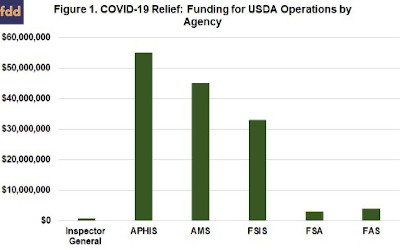By Jonathan Coppess, Nick Paulson et.al
Department of Agricultural and Consumer Economics
University of Illinois
By Carl Zulauf
Department of Agricultural, Environmental and Development Economics
Ohio State University
On Friday, March 27, 2020, Congress passed, and President Trump signed into law, the 3rd FY2020 Coronavirus Supplemental Appropriations Act (P.L. 116-136). At a reported appropriation of $2 trillion, the bill is the largest federal economic relief measure ever enacted (Snell, March 26, 2020; Siegel-Bernard and Lieber, March 28, 2020; Cochrane, March 30, 2020). This article reviews the funding for USDA agencies and programs in the Coronavirus Aid, Relief, and Economic Security (CARES) Act, including reimbursement of Commodity Credit Corporation (CCC) expenditures, rural assistance and food assistance.
Background
On December 31, 2019, China first confirmed an outbreak of the novel coronavirus with its first reported death on January 11, 2020; the first confirmed case in the U.S. was in Washington State around January 20-21, 2020, by a man in his thirties who had traveled from Wuhan, China on January 15, 2020 (Taylor, March 27, 2020; Rabin, January 21, 2020). On January 30, 2020, the World Health Organization (W.H.O.) declared a global health emergency and on February 11, the W.H.O. officially named the disease caused by the novel coronavirus as COVID-19. The first reported death in the United States was in Seattle on February 28, the same date that infections in Europe were reported to have spiked. As of April 1, 2020, the Centers for Disease Control and Prevention (CDC) reported 186,101 cases in the United States (CDC Coronavirus Disease 2019). As many as 941,000 people are reported to have been infected with the novel coronavirus worldwide (CNN).
The $2 trillion relief package began with a bill negotiated among Senate Republicans released on March 19, 2020, followed by five days of negotiations and approval by the Senate by a margin of 96 to 0 just before midnight on Wednesday, March 25, 2020 (Cochrane, Tankersley and Rappeport, March 19, 2020; Cochrane and Fandos, March 25, 2020). The House of Representatives passed the measure by voice vote on March 27, 2020, after avoiding an attempt to use procedural maneuvers to block action; President Trump signed it that evening (Cochrane and Stolberg, March 27, 2020). Barely more than a week from introduction to signing of the bill represents an extraordinarily rapid turnaround by Congress of legislation to respond to this public health emergency; more stunning still given the sheer size of expected spending and the scope of the reach of the bill’s provisions.
Discussion: USDA Funding in the CARES Act
The coronavirus relief bill titled Coronavirus Aid, Relief, and Economic Security or CARES Act contains two Divisions (H.R. 748). The Division A addresses assistance to employees and businesses, as well as assistance to the health care system and providers. It also includes economic stabilization provisions for severely distressed sectors of the U.S. economy. Division B of the bill includes emergency supplemental appropriations provisions for various accounts or to agencies for use in response. The funding for the U.S. Department of Agriculture accounts are in this Division, with the bill providing a total of $48.4 billion. These funds can be divided into two basic categories: (1) operational funding for salaries and other expenses to cover costs for response efforts or usual operating efforts that have required additional costs; and (2) direct relief funding or reimbursement for funds previously spent in direct assistance. The following discussion reviews the funding in these two categories.
(1) Funding for USDA Operational Needs
In general, the bill provides $140.75 million to USDA agencies for helping with salaries and expenses in light of the coronavirus pandemic. For example, the Animal and Plant Health Inspection Service (APHIS) is appropriated an additional $55 million to “prevent, prepare for, and respond to” the pandemic, including costs for the Agriculture Quarantine and Inspection Program. The Agricultural Marketing Service (AMS) is also appropriated additional amounts ($45 million) for prevention, preparation and response, including additional costs for grading, inspecting and audit activities for commodities. The Food Safety and Inspection Service (FSIS) received an additional $33 million for its efforts, including supporting temporary workers or relocating inspectors, as well as overtime for inspectors under the Federal Meat Inspection Act, the Poultry Products Inspection Act, and the Egg Products Inspection Act. Figure 1 illustrates the emergency funding appropriated to the various USDA agency accounts.

Note that the Farm Service Agency (FSA) received additional funds ($3 million) to cover additional expenses, including for temporary staff and overtime, while the Foreign Agricultural Service (FAS) received additional funds ($4 million) that included expenses for relocating employees and dependents from overseas posts. Finally, the Office of the Inspector General (OIG) received $750,000 for audits and investigations of the activities carried out and expenditures under this emergency act.
(2) Funding for Direct Assistance
In total, this is the largest portion of the funding provided in the CARES Act to USDA at just over $48.3 billion. Funds are largely for three different program activities. The first, illustrated in Figure 2, are the funds for providing direct assistance to producers. The $23.5 billion includes $9.5 billion to the Secretary of Agriculture to support producers impacted by coronavirus but it specifically mentions “producers of specialty crops, producers that supply local food systems, including farmers markets, restaurants, and schools” as well as “livestock producers, including dairy producers” (Division B, Title I). The way it is written, it appears unlikely that any of these funds are to be used to support producers of the commodities generally covered in Title I of a farm bill (except dairy).